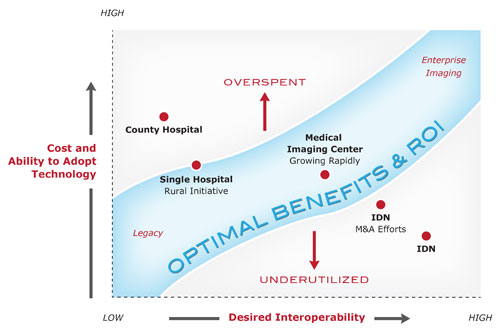
Critical to evaluating your investments across people, processes and technology is determining where your imaging business currently sits within the graph.
“Presentism” is the idea and adherence to view current situations as inevitable and as status quo. Consider your medical imaging operations and the business requirements for further optimization and integration — they will be successful if you can chart where you are currently and navigate to the desired objective, which may or may not be enterprise imaging. The qualitative and quantitative components of return on investment (ROI) will be afforded to those healthcare systems that don’t over-spend or underutilize on their journey. Critical to evaluating your investments across people, processes and technology is determining where your imaging business currently sits within the graph.
Navigating to the “Optimal”
Once you have identified the close proximity of your organization’s current location, you can review the representative (but not exhaustive) list of best practices for negotiating and achieving future success. Avoid overspending and underutilization:
• Research, codify and communicate a comprehensive roadmap/business plan to develop and drive objectives, resources, costs and timelines. Due to the rapid nature of innovation and the potential of unique needs based on existing technology, processes and organizational requirements, your organization must be driven by the clock and the objective. Building your organization’s ability to rapidly adopt and leverage enterprise solutions across the continuum of patient care is invaluable
and necessary;
• Involve top management to support the implementation, culture of adoption and the constant requirements of driving the process. The implementation team will need access and timely feedback on criteria for financing, resources, organizational and strategy factors as they emerge. Often, we see the momentum and ROI of an initiative affected by the human factor of those involved — consistency with some flexibility is key;
• Understand you current state — include long-term existing contracts, piloted solutions, “sacred cow” systems, opportunity costs and the relationship to other legacy systems. Organizations that value existing solutions may discover features and functions that have lain dormant or have not been fully recognized for their capabilities, interoperability or new and powerful R&D efforts;
• Utilization of experienced health information technology (HIT) consultants to objectively analyze, design and deploy components of the initiative will increase the speed of adoption and reduce disruption. Within the organization’s team there may be gaps in knowledge, experience or training. Consultants can add tremendous value to the implementation team during the project;
• As your health system considers enterprise-scale systems, the organization must have a comprehensive and objective knowledge of the existing — and the emerging — market. Evaluate technologies and how their pricing, evolving development roadmaps and support contracts correlate with the organization’s future state requirements. Continuously evaluate key vendors on the technical, but also the clinical and business components. The market is hungry, so negotiate for win-win deals.
Electronic health records (EHR) and other HIT efforts have been rife with industry reports of overspending and underutilization. If this has been your organization’s experience, then accept the lessons learned and apply them toward the next generation of enterprise efforts. I often tell my son that in situations he is encountering, if possible, he must observe, reflect and then determine how he might engage. An engaged, managed and successful implementation of an enterprise imaging solution is possible with the right goals, the right people and governance, and the right perception. Innovation is about challenges and opportunities. Don’t let your present environment define your future path. itn
Hjalmer Danielson is a former vice president for Ascendian Healthcare Consulting and a frequent contributor on the subject of health information technology.


 December 01, 2025
December 01, 2025 









